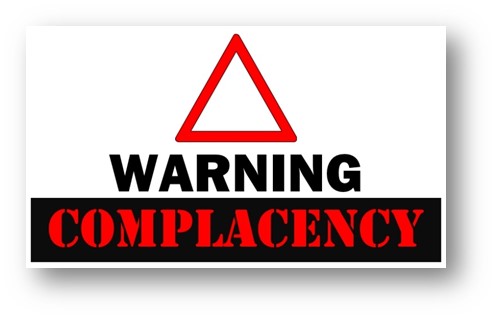Are you satisfied with your supply chain's performance? Are you satisfied with your customer service levels? How about lead times?
Are you satisfied with how much you are spending (wasting?) on expediting expenses and excess freight costs when things go wrong?
 Here's the more important question
Here's the more important question
Are you satisfied because you are confident that you have a real and effective POOGI (process of on-going improvement) in place, and improvement is happening incrementally, day-in and day-out? Or, are you "complacent" because profits are "good enough," and you really don't want to do anything for fear of making things worse instead of better?
"Good enough" stopped being good enough a long time ago
In today's highly competitive global economy, "good enough" stopped being good enough a long, long time ago. If you are not improving, you are falling backwards.
Are out-of-stocks still disrupting flows in your supply chain?
Have you invested heavily in your ERP system, but still finding that you have to work around your ERP—using spreadsheets and other means—to determine what supply chain actions you need to take on the production floor and in your supply chain?
Changing what you measure will change how you manage
Traditional MRP (material requirements planning) is ready for retirement. Traditional MRP was really designed in the post-World War II era, codified by Joe Orlicky in the mid-1970s, and implemented into software for business in the 1980s and 1990s.
Hey! Traditional MRP is already more than 65 years old! It's ready for retirement! It's long past its prime and was designed for an era where manufacturing capacity was far below market demand, and supply chains were relatively short (not global).
Don't get me wrong! There are some important elements in traditional MRP that cannot be entirely ignored. But, for a great many companies, it just does not provide what they need for real improvement.
DDMRP (Demand Driven MRP) is traditional MRP's logical successor.
By incorporating the best of what is found in traditional MRP, Lean theory and practice (the Toyota Production System), and Theory of Constraints, it has proven to be an effective method for rapid improvement and almost immediate return on investment.
Demand driven MRP works because it changes what you measure, and it helps supply chain managers focus on—and effectively manage—what is important. It provides clear—absolutely unambiguous—signals to management regarding priorities.
While traditional MRP can—in some cases—accurately tell you what you need, it supplies no information that will help supply chain managers strategically position inventories and appropriately size inventory buffers. DDMRP accomplishes that using methods that are easily comprehended by those applying its methods.
DDMRP changes what management measures and how management thinks about improving supply chain flow.
About results
Typical (read: average) results from a conscientiously applied effort in the implementation of DDMRP look like this:
- Order fill rates increased from below 70 percent to the high 90 percent range
- Out of stocks dramatically reduced
- Lead times significantly cut, thus providing a competitive advantage
- Inventory levels reduced—sometimes as much as 40 percent—while reducing out-of-stock and increasing order fill rates
- Productivity increased to the extent that new capacities are uncovered and new opportunities opened
Campaign against complacency
As Albert Einstein so cogently observed: "We cannot solve our problems at the same level of thinking that created them."
If you are still trying to solve your supply chain problems—internal or external—using the same thinking you have been trying for the last decade or longer, your present complacency probably stems from just being worn out. You are exhausted by fighting the same battles over and over again while finding sustainable improvement always just out of reach.
It's time to change your thinking. We suggest that you investigate DDMRP.
Real improvement begins with new thinking! Depending upon your situation, new software or hardware may be entirely optional to achieve new levels of performance.



